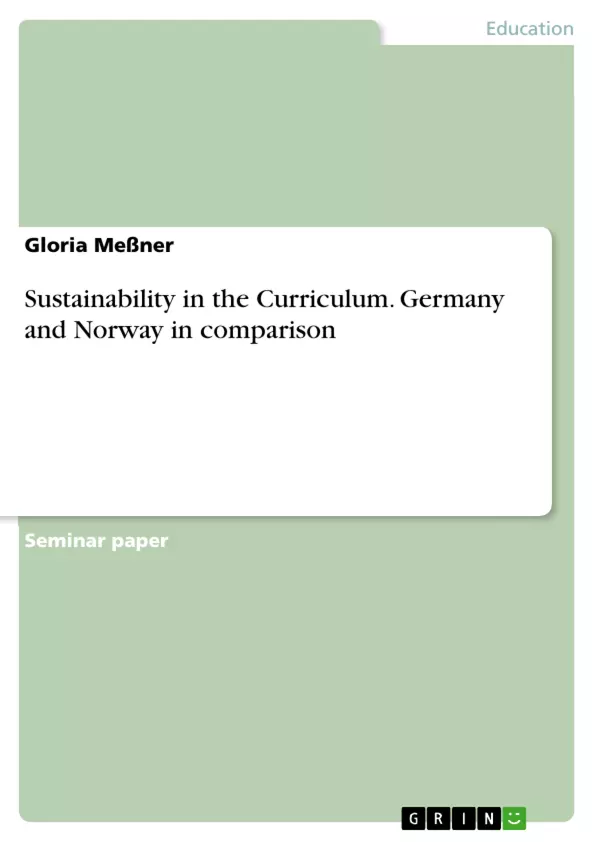The aim of this paper is to show to what extent matters of environmental sustainability are anchored in the Norwegian curriculum in comparison to the Bavarian curriculum.
Specifically, this means examining how many areas of the curricula address environmental aspects by looking at the chapters for mentions of them. This is to be done with the help of a qualitative content analysis of the curricula, followed by a critical comparison.
However, this is by no means a complete evaluation of the Norwegian or the German curriculum but merely a review of the presence and interdisciplinary inclusion of environmental sustainability, sustainable development, and education for sustainable development in the various curricula.
Responsible use of the earth's available resources is one of the most fundamental guiding themes of our time. Environmental changes affect society and everyday life, creating enormous challenges for the present, but especially for future generations.
Whether it is energy consumption, the use of raw materials, waste disposal or the volume of traffic – new solutions need to be found urgently so that the basis of human life can be permanently preserved.
However, all aspects of sustainable development and their interactions shall always be taken into account. The fact that children and in particular teenagers see sustainable development as a pressing issue for the future is demonstrated, for example, by the worldwide activities of "Fridays for Future" and similar global social movements. And since one essential goal of education is to provide young people with orientation and enable them to take responsibility for shaping their own future, the education system has a crucial role to play here.
Inhaltsverzeichnis (Table of Contents)
- Introduction to the subject matter
- Course of action
- Fundamentals
- The German education system
- The Norwegian education system
- Basic terms
- (Environmental) Sustainability
- Sustainable development
- Education for Sustainable Development
- Methodological approach
- Qualitative content analysis according to Mayring
- Qualitative content analysis by Mayring: description and application
- Category system
- Presenting the results
- Curriculum in Bavaria
- Curriculum in Norway
- Comparison of the results
- Conclusion and outlook
Zielsetzung und Themenschwerpunkte (Objectives and Key Themes)
The aim of this paper is to compare the extent to which environmental sustainability is integrated within the Norwegian curriculum in relation to the Bavarian curriculum. This study analyzes the presence and interdisciplinary inclusion of environmental sustainability, sustainable development, and education for sustainable development within these respective curricula.
- Comparison of educational systems in Germany and Norway
- Definition and explanation of key terms: sustainability, environmental sustainability, sustainable development, education for sustainable development
- Methodological approach: qualitative content analysis
- Analysis of the Bavarian and Norwegian curricula
- Comparison of findings and recommendations
Zusammenfassung der Kapitel (Chapter Summaries)
The first chapter provides an introduction to the subject matter of environmental sustainability and its relevance in the context of present and future generations. The paper highlights the growing awareness of sustainability issues and the crucial role of education in promoting change. It further discusses the global initiatives and the specific focus on Germany and Norway as case studies for examining educational approaches to sustainable development.
The second chapter outlines the course of action for the paper, which involves a comparative analysis of the Norwegian and Bavarian curricula through qualitative content analysis. It explains the method and its application in the context of this study.
The third chapter presents the fundamental information about the German and Norwegian education systems, with a specific focus on the Bavarian education system. This includes a discussion of the structure and organization of the education system, its key components, and the relevant legislation and regulations.
Schlüsselwörter (Keywords)
The key terms and topics explored in this study include: environmental sustainability, sustainable development, education for sustainable development, qualitative content analysis, curriculum analysis, comparative education, German education system, Norwegian education system, Bavaria.
- Quote paper
- Gloria Meßner (Author), 2022, Sustainability in the Curriculum. Germany and Norway in comparison, Munich, GRIN Verlag, https://www.grin.com/document/1243199



